
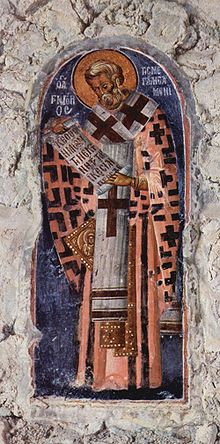
The epigonation (Greek: ἐπιγονάτιον, literally meaning "over the knee"), or pálitsa (Russian: па́лица, "club"), is a vestment used in some Eastern Christian churches.


The epigonation (Greek: ἐπιγονάτιον, literally meaning "over the knee"), or pálitsa (Russian: па́лица, "club"), is a vestment used in some Eastern Christian churches.
In Eastern Orthodoxy and Eastern Catholic Churches which follow the Byzantine Rite the palitza is worn by all bishops, and as an ecclesiastical award for some priests. [1] : xxxviii Its origin is traced to the practice of Byzantine Emperors awarding ceremonial swords to their military commanders in recognition of their valour in defending the empire. Such swords were often accompanied by elaborate thigh-shields which were suspended from the belt and protected the leg from bruising caused by the constant bumping of the sword against the thigh. When the emperors began to give awards to the clergy, the thigh-shield alone was awarded. [2]
The vestment is a stiff, lozenge-shaped cloth that hangs on the right side of the body below the waist, suspended by one corner from a strap drawn over the left shoulder. In the Russian tradition it is an award for service; in the Greek tradition it is usually a sign that the priest has an advanced academic degree and a blessing to hear confessions. If a Russian priest has been awarded both the nabedrennik and the palitza, he shifts the former to the left side. It is considered to symbolise the "sword of the Spirit, which is the Word of God" (Ephesians 6:17); that is to say, the wearer's defending of the faith by smiting all that is impure and vicious. [2]
Upon donning his palitza, the cleric prays: "Gird thy sword upon thy thigh, O Mighty One, in thy comeliness and thy beauty; and exert, and fare Thee well, and reign in the name of truth, and of meekness, and of justice; and Thy right hand shall guide Thee wondrously. Now and ever, and unto the ages of ages. Amen".[ citation needed ]
This section needs additional citations for verification .(July 2021) |
The epigonation's origin is uncertain. According to some authorities it was a decorated tablion or thigh-shield awarded to officials in the Byzantine Empire, originally military and later civilian. According to others it was originally an ornamental handkerchief, called at that date encheirion, "hand cloth", which received its present form and name in the twelfth century. [3] The encheirion is first depicted in the Menologion of Basil II. [3] In the former case it has no Western Christian counterpart; in the latter it would correspond to the Sub-cinctorium, used by Roman popes in solemn masses.
It is also said that it was used to carry documents relating to one's position in the Church. Papers such as those certifying one's ordination and rank would be most relevant when travelling. Carrying them in the Liturgy would be symbolic of bearing one's authority to conduct the Holy things of the Liturgy.
During the Mystery (Sacrament) of Ordination, a priest or deacon is taken in procession three times around the Holy Table (altar), after each circuit he bows down before the bishop and kisses his epigonation and his right hand. [1] : 311 Also, in some liturgical traditions, when a bishop performs a lesser ordination, such as the setting-apart of a subdeacon, he lays his epigonation over the candidate's head as he says the prayer.
The gonker (epigonation) is used exclusively by the two Catholicoi of the Armenian Apostolic Church and is granted occasionally with special authorization to patriarchs. [4] The Catholicos of the Armenian Catholic Church also wears it, although it does not appear to be exclusive to him. The recently ordained archbishop for the Armenian Catholic Archeparchy of Constantinople wore a gonker at his ordination. [5]
An image of Saint Blaise of Sebaste in the Armenian Catholic parish of San Nicola da Tolentino in Rome depicts the saint wearing a gonker. [6]
Gird thee with thy sword upon thy thigh, O thou most Mighty: according to thy worship and renown.
Good luck have thou with thine honour: ride on, because of the word of truth , of meekness, and righteousness; and thy right hand shall teach thee terrible things. (Psalm 45: 4-5)
Always, now and ever, and unto ages of ages.
Subdeacon is a minor order of ministry for men in various branches of Christianity. The subdeacon has a specific liturgical role and is placed below the deacon and above the acolyte in the order of precedence.
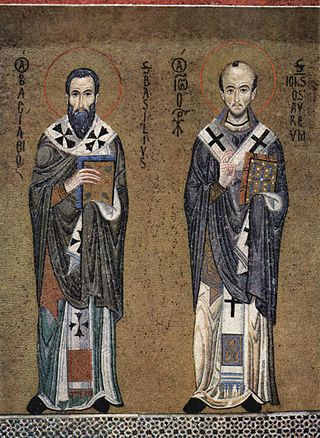
Divine Liturgy or Holy Liturgy is the usual name used in most Eastern Christian rites for the Eucharistic service.

The epiclesis refers to the invocation of one or several gods. In ancient Greek religion, the epiclesis was the epithet used as the surname given to a deity in religious contexts. The term was borrowed into the Christian tradition, where it designates the part of the Anaphora by which the priest invokes the Holy Spirit upon the Eucharistic bread and wine in some Christian churches. In most Eastern Christian traditions, the Epiclesis comes after the Anamnesis ; in the Western Rite it usually precedes. In the historic practice of the Western Christian Churches, the consecration is effected at the Words of Institution though during the rise of the Liturgical Movement, many denominations introduced an explicit epiclesis in their liturgies.
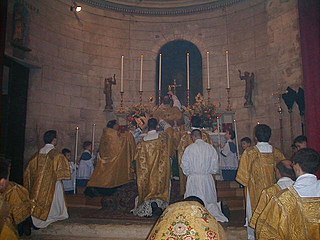
Vestments are liturgical garments and articles associated primarily with the Christian religion, especially by Eastern Churches, Catholics, Lutherans, and Anglicans. Many other groups also make use of liturgical garments; among the Reformed (Calvinist) Churches this was a point of controversy in the Protestant Reformation and sometimes since, in particular during the ritualist controversies in the Church of England in the 19th century.

The mitre or miter is a type of headgear now known as the traditional, ceremonial headdress of bishops and certain abbots in traditional Christianity. Mitres are worn in the Catholic Church, Eastern Orthodox Church, Oriental Orthodox Churches, the Anglican Communion, some Lutheran churches, for important ceremonies, by the Metropolitan of the Malankara Mar Thoma Syrian Church, and also, in the Catholic Church, all cardinals, whether or not bishops, and some Eastern Orthodox archpriests.

Consecration is the transfer of a person or a thing to the sacred sphere for a special purpose or service. The word consecration literally means "association with the sacred". Persons, places, or things can be consecrated, and the term is used in various ways by different groups. The origin of the word comes from the Latin stem consecrat, which means dedicated, devoted, and sacred. A synonym for consecration is sanctification; its antonym is desecration.

Epimanikia are liturgical vestments of the Eastern Orthodox Church and Eastern Catholic Churches. They are cuffs made of thickened fabric, usually brocade, that lace onto the wrists of a bishop, priest, or deacon. There is usually a cross embroidered or appliquéd to the center.
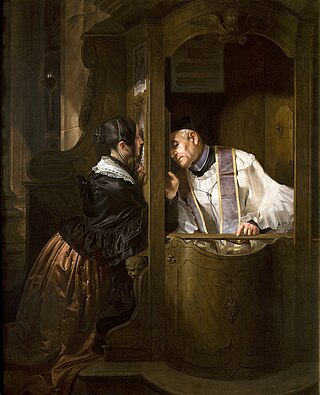
Absolution is a theological term for the forgiveness imparted by ordained Christian priests and experienced by Christian penitents. It is a universal feature of the historic churches of Christendom, although the theology and the practice of absolution vary between Christian denominations.

The sakkos is a vestment worn by Orthodox and Greek Catholic bishops instead of the priest's phelonion. The garment is a tunic with wide sleeves, and a distinctive pattern of trim. It reaches below the knees and is fastened up the sides with buttons or tied with ribbons. It is similar in form to the western dalmatic, which is similarly derived from Byzantine dress. The sakkos was originally worn by the Emperor as an imperial vestment, symbolizing the tunic of disgrace worn by Christ during his trial and mockery.
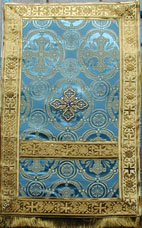
A nabedrennik is a vestment worn by some Russian Orthodox priests. It is a square or rectangular cloth. Like the epigonation, it is worn at the right hip, suspended from a strap attached to the two upper corners of the vestment and drawn over the left shoulder; however, if the priest also wears an epigonation, then the nabedrennik is worn at the left hip, drawn over the right shoulder.

In Eastern Orthodox and Byzantine Catholic churches, an entrance is a procession during which the clergy enter into the sanctuary through the Holy Doors. The origin of these entrances goes back to the early church, when the liturgical books and sacred vessels were kept in special storage rooms for safe keeping and the procession was necessary to bring these objects into the church when needed. Over the centuries, these processions have grown more elaborate, and nowadays are accompanied by incense, candles and liturgical fans. In the liturgical theology of the Eastern Orthodox Church, the angels are believed to enter with the clergy into the sanctuary, as evidenced by the prayers which accompany the various entrances.

Antiochene Rite also known as Antiochian Rite refers to the family of liturgies originally used by the patriarch of Antioch.

The Gospel in Christian liturgy refers to a reading from the Gospels used during various religious services, including Mass or Divine Liturgy (Eucharist). In many Christian churches, all present stand when a passage from one of the Gospels is read publicly, and sit when a passage from a different part of the Bible is read. The reading of the Gospels, often contained in a liturgical edition containing only the four Gospels, is traditionally done by a minister, priest or deacon, and in many traditions the Gospel Book is brought into the midst of the congregation to be read.
In liturgical use the term preface is a formal thanksgiving that immediately precedes the Canon, Eucharistic Prayer, Prayer of Consecration or analogous portion of the Eucharist. The preface, which begins at the words, "It is very meet and just, right and salutary" is ushered in, in all liturgies, with the Sursum corda and ends with the Sanctus.

Vesting prayers are prayers which are spoken while a cleric puts on vestments as part of a liturgy, in both the Eastern and Western churches. They feature as part of the liturgy in question itself, and take place either before or after a liturgical procession or entrance to the sanctuary, as depends on the particular liturgical rite or use which is being observed.
Pontifical vestments, also referred to as episcopal vestments or pontificals, are the liturgical vestments worn by bishops in the Catholic, Eastern Orthodox, Oriental Orthodox, Anglican, and some Lutheran churches, in addition to the usual priestly vestments for the celebration of the mass, other sacraments, sacramentals, and canonical hours. The pontifical vestments are only worn when celebrating or presiding over liturgical functions. As such, the garments should not be confused with choir dress, which are worn when attending liturgical functions but not celebrating or presiding.

The entrance prayers are the prayers recited by the deacon and priest upon entering the temple before celebrating the Divine Liturgy in the Eastern Orthodox Church and those Eastern Catholic Churches which follow the Byzantine Rite.
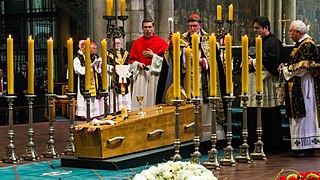
Absolution of the dead is a prayer for or a declaration of absolution of a dead person's sins that takes place at the person's religious funeral.

The Liturgy of Addai and Mari is the Eucharistic liturgy belonging to the East Syriac Rite and was historically used in the Church of the East of the Sasanian (Persian) Empire. This liturgy is traditionally attributed to Saint Addai and Saint Mari. It is currently in regular use in the Assyrian Church of the East, the Ancient Church of the East, the Syro-Malabar Catholic Church of India, and the Chaldean Catholic Church. The latter two are Eastern Catholic churches in full communion with the Holy See of Rome.
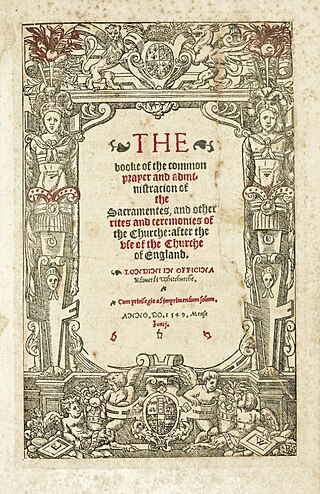
The 1549 Book of Common Prayer (BCP) is the original version of the Book of Common Prayer, variations of which are still in use as the official liturgical book of the Church of England and other Anglican churches. Written during the English Reformation, the prayer book was largely the work of Thomas Cranmer, who borrowed from a large number of other sources. Evidence of Cranmer's Protestant theology can be seen throughout the book; however, the services maintain the traditional forms and sacramental language inherited from medieval Catholic liturgies. Criticised by Protestants for being too traditional, it was replaced by the significantly revised 1552 Book of Common Prayer.